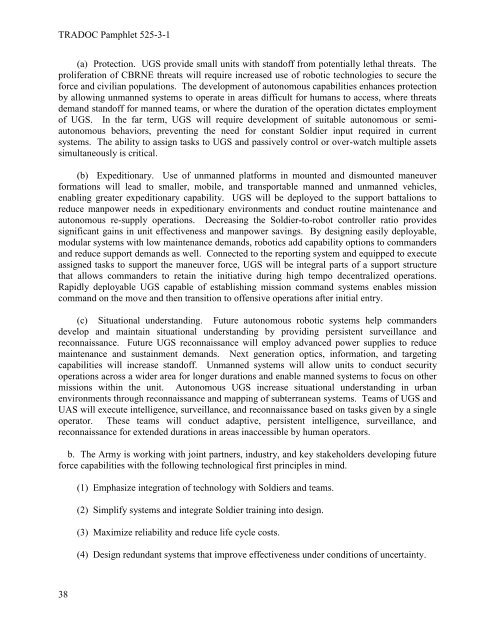TP525-3-1
TP525-3-1
TP525-3-1
Create successful ePaper yourself
Turn your PDF publications into a flip-book with our unique Google optimized e-Paper software.
TRADOC Pamphlet 525-3-1<br />
(a) Protection. UGS provide small units with standoff from potentially lethal threats. The<br />
proliferation of CBRNE threats will require increased use of robotic technologies to secure the<br />
force and civilian populations. The development of autonomous capabilities enhances protection<br />
by allowing unmanned systems to operate in areas difficult for humans to access, where threats<br />
demand standoff for manned teams, or where the duration of the operation dictates employment<br />
of UGS. In the far term, UGS will require development of suitable autonomous or semiautonomous<br />
behaviors, preventing the need for constant Soldier input required in current<br />
systems. The ability to assign tasks to UGS and passively control or over-watch multiple assets<br />
simultaneously is critical.<br />
(b) Expeditionary. Use of unmanned platforms in mounted and dismounted maneuver<br />
formations will lead to smaller, mobile, and transportable manned and unmanned vehicles,<br />
enabling greater expeditionary capability. UGS will be deployed to the support battalions to<br />
reduce manpower needs in expeditionary environments and conduct routine maintenance and<br />
autonomous re-supply operations. Decreasing the Soldier-to-robot controller ratio provides<br />
significant gains in unit effectiveness and manpower savings. By designing easily deployable,<br />
modular systems with low maintenance demands, robotics add capability options to commanders<br />
and reduce support demands as well. Connected to the reporting system and equipped to execute<br />
assigned tasks to support the maneuver force, UGS will be integral parts of a support structure<br />
that allows commanders to retain the initiative during high tempo decentralized operations.<br />
Rapidly deployable UGS capable of establishing mission command systems enables mission<br />
command on the move and then transition to offensive operations after initial entry.<br />
(c) Situational understanding. Future autonomous robotic systems help commanders<br />
develop and maintain situational understanding by providing persistent surveillance and<br />
reconnaissance. Future UGS reconnaissance will employ advanced power supplies to reduce<br />
maintenance and sustainment demands. Next generation optics, information, and targeting<br />
capabilities will increase standoff. Unmanned systems will allow units to conduct security<br />
operations across a wider area for longer durations and enable manned systems to focus on other<br />
missions within the unit. Autonomous UGS increase situational understanding in urban<br />
environments through reconnaissance and mapping of subterranean systems. Teams of UGS and<br />
UAS will execute intelligence, surveillance, and reconnaissance based on tasks given by a single<br />
operator. These teams will conduct adaptive, persistent intelligence, surveillance, and<br />
reconnaissance for extended durations in areas inaccessible by human operators.<br />
b. The Army is working with joint partners, industry, and key stakeholders developing future<br />
force capabilities with the following technological first principles in mind.<br />
(1) Emphasize integration of technology with Soldiers and teams.<br />
(2) Simplify systems and integrate Soldier training into design.<br />
(3) Maximize reliability and reduce life cycle costs.<br />
(4) Design redundant systems that improve effectiveness under conditions of uncertainty.<br />
38


